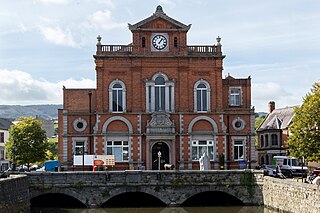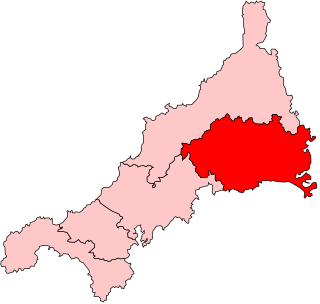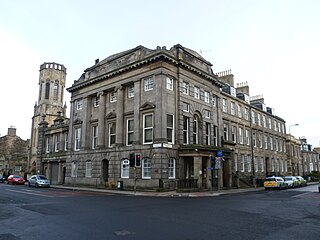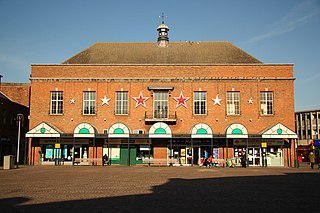
Lanhydrock House, commonly known simply as Lanhydrock, is a country house and estate in the parish of Lanhydrock, Cornwall, UK.

Wadebridge is a town and civil parish in north Cornwall, England, United Kingdom. The town straddles the River Camel five miles upstream from Padstow. The permanent population was 6,222 in the census of 2001, increasing to 7,900 in the 2011 census. There are two electoral wards in the town. Their total population is 8,272.

Newry Town Hall is a municipal structure in Bank Parade in Newry, Northern Ireland. It was built on a specially-constructed bridge across the Newry River, which forms part of the historic border between County Armagh and County Down. The town hall, which was the headquarters of Newry Urban District Council, is a Grade B1 listed building.

Bodmin Parkway railway station is on the Cornish Main Line that serves the nearby town of Bodmin and other parts of mid-Cornwall, England. It is situated 3 miles (4.8 km) south-east of the town of Bodmin in the civil parish of St Winnow, 274 miles 3 chains from London Paddington measured via Box and Plymouth Millbay.

Bodmin was the name of a parliamentary constituency in Cornwall from 1295 until 1983. Initially, it was a parliamentary borough, which returned two Members of Parliament to the House of Commons of England and later the House of Commons of the Parliament of the United Kingdom until the 1868 general election, when its representation was reduced to one member.

Wadebridge railway station was on the Bodmin and Wadebridge Railway, in Cornwall, England, UK. It opened in 1834 to transport goods between the market town of Wadebridge, the limit of navigation on the River Camel, and inland farming and mining areas. The railway was built to take stone from local quarries such as the De Lank Quarries on Bodmin Moor towards the coast, as well as sand dredged from the River Camel and landed at the quays in Wadebridge inland to be used to improve the heavy local soil. The station is situated just upstream of Wadebridge bridge and almost next to the tidal River Camel; a fact that prompted the former Poet Laureate John Betjeman to write in his autobiography "On Wadebridge station what a breath of sea scented the Camel Valley! Cornish air, soft Cornish rains, and silence after steam".

Thomas Charles Reginald Agar-Robartes was a British Liberal politician.

Corn exchanges in England are distinct buildings which were originally created as a venue for corn merchants to meet and arrange pricing with farmers for the sale of wheat, barley, and other corn crops. The word "corn" in British English denotes all cereal grains, such as wheat and barley. With the repeal of the Corn Laws in 1846, a large number of corn exchanges were built, particularly in the corn-growing areas of Eastern England. However, with the fall in price of English corn as a result of cheap imports, corn exchanges mostly ceased to be built after the 1870s. Increasingly they were put to other uses, particularly as meeting and concert halls. Many found a new lease of life in the early 20th century as cinemas. Following the Second World War, many could not be maintained, and they were demolished. In the 1970s their architectural importance came to be appreciated, and most of the surviving examples are listed buildings. Most of the surviving corn exchanges have now been restored, and many have become arts centres, theatres, or concert halls.

Macclesfield Town Hall is a Georgian municipal building in the Market Place in Macclesfield, Cheshire, England. The building incorporates the former Borough Police Station. The town hall is listed at grade II*.

Towcester Town Hall is a municipal building in Watling Street, Towcester, Northamptonshire, England. The town hall, which is the meeting place of Towcester Town Council, is a grade II listed building.

The Old Town Hall is a municipal building in Queen Charlotte Street, Leith, Scotland. The old town hall, which was the meeting place of Leith Burgh Council, is now used as a police station. It is a Category A listed building.

Gainsborough Town Hall is a municipal building in the Market Place in Gainsborough, Lincolnshire, England. The town hall was the headquarters of Gainsborough Urban District Council.

The Municipal Buildings are based on the north side of High East Street in Dorchester, Dorset, England. The structure, which was the headquarters of Dorchester Borough Council, is a Grade II* listed building.

St John's Hall, formerly known as the Public Buildings, Penzance, is a municipal building in Alverton Street, Penzance, Cornwall, England. The structure, which was the headquarters of Penzance Borough Council, is a Grade II listed building.

Saltcoats Town Hall is a municipal building in Countess Street, Saltcoats, Scotland. The building, which is used by North Ayrshire Council as hub for the delivery of local services, is a Category B listed building.

Helston Guildhall, also known as Helston Town Hall, is a municipal building in Church Street, Helston, Cornwall, England. The structure, which is the meeting place of Helston Town Council, is a Grade II* listed building.

The Municipal Buildings are based on The Moor in Falmouth, Cornwall, England. The structure, which currently accommodates both Falmouth Art Gallery and Falmouth Library, is a Grade II listed building.

Ballyclare Town Hall is a municipal structure in The Square, Ballyclare, County Antrim, Northern Ireland. The structure, which is primarily used as an events venue, is a Grade B2 listed building.

Portadown Town Hall is a municipal structure in Edward Street, Portadown, County Armagh, Northern Ireland. The structure, which is primarily used as a theatre, is a Grade B1 listed building.

The Old Town Hall is a building on Church Street in the market town of Poulton-le-Fylde in Lancashire, England. The building, which is located at the northern end of Market Square, started life as a public house before becoming a municipal building and then reverting to use as a public house.






















